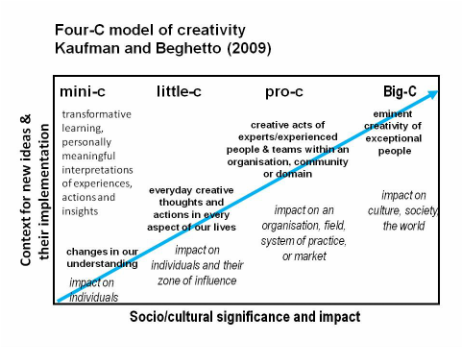
The Four-C model of creativity proposed by Kaufman and Beghetto (2009).
Both mini-c and little-c forms of creativity are relevant to higher education learning and curriculum designs, teaching and learning strategies could usefully encourage and facilitate these. One might speculate that participation in these forms of creativity are pre-requisite for Pro-c and Big-C creativity in later life: if we want creative professionals then we should be encouraging students to be creative. It is however important to note that 'everyday creativity can extend from mini-c to little-c through Pro-c. It is only Big-C that remains eminent creativity (ibid:6) beyond the reach of most of us. From an educational perspective it might be reasoned that by encouraging and empowering students to use, develop and make claims for mini-c and little-c forms of creativity, we are better preparing them not only for using these forms in later life but for engaging in more expert-based forms of creativity that emerges through sustained engagement with a particular domain or field of activity.
Does this provide a useful way of visualising how you and your creativity fits into the creativity of humankind?
Using your own creativity? Can you enrich this model or propose an alternative one that makes sense to you?
Source:
Kaufman, J.C. and Beghetto, R.A. (2009) Beyond Big and Little: The Four C Model of Creativity. Review of General Psychology 13, 1, 1-12.
Download their article
| the-four-c-model-of-creativity.pdf |
 RSS Feed
RSS Feed